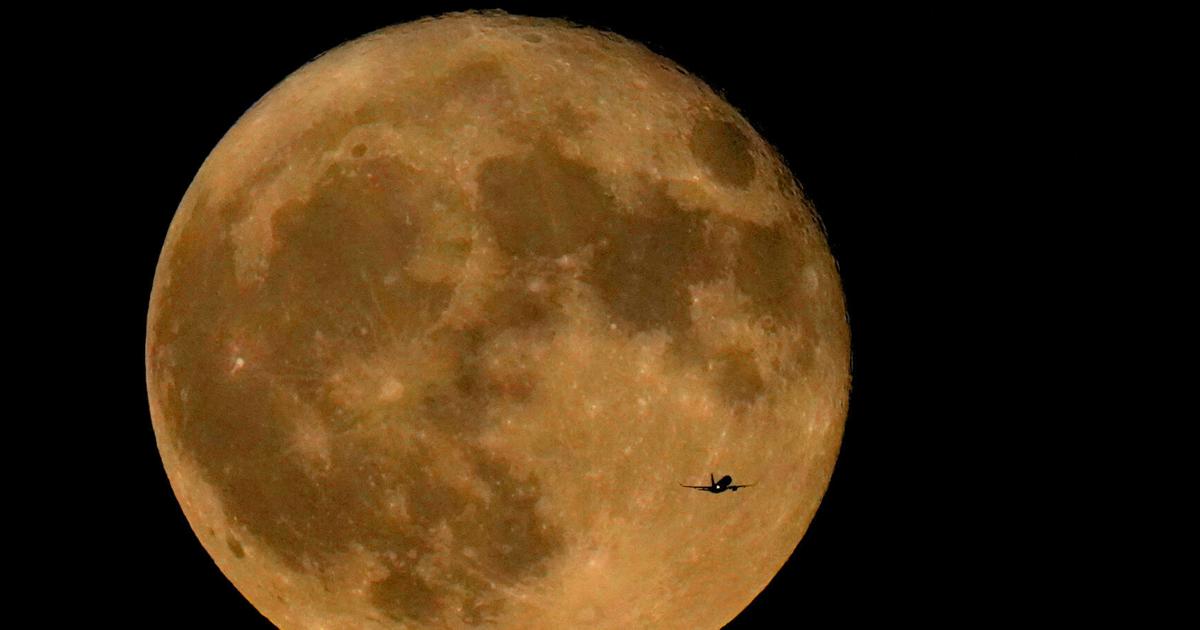Two supermoons in August mean double the stargazing fun
The last time two full supermoons graced the sky in the same month was in 2018. It's not expected to happen again until 2037. The moon is seen in its waxing gibbous stage Nov. 13, 2016, and is expected to bring stronger than usual high tides and a 14 percent larger in diameter when it approaches its closest full moon to Earth in November. The upcoming supermoon, on Nov. 14, will be especially "super" because it's the closest fullmoon to Earth since 1948. The brightest moon in almost 69 years is lighting up the sky this week in a treat for star watchers around the globe. The moon will be at its brightest this week due to its elliptical orbit and its proximity to Earth.

发表 : 2年前 经过 MARCIA DUNN Associated Press 在 Science
Beth Huddleston photographs the moon with her cellphone Nov. 13, 2016, as it rises over Winchester, Va. A supermoon occurs when the moon is full and passing close to the earth in its orbit. (Jeff Taylor/The Winchester Star via AP)
The moon rises Nov. 13, 2016, beyond flags atop Fraser Hall on the University of Kansas campus in Lawrence, Kan. (AP Photo/Orlin Wagner)
The moon is seen in its waxing gibbous stage Nov. 13, 2016, behind the head of the Christopher Columbus statue at Columbus Circle in New York. (AP Photo/Julio Cortez)
The moon rises over Hefer Valley in Israel, Sunday, Nov. 13, 2016. The upcoming supermoon, on Nov. 14, will be especially "super" because it's the closest full moon to Earth since 1948. (AP Photo/Ariel Schalit)
On the eve of the so-called supermoon, visitors enjoy an unobstructed view of the spectacle as it ascends over the Lake Michigan shoreline Nov. 13, 2016, in Milwaukee, Wis. (John Hart/Wisconsin State Journal via AP)
The supermoon rises Nov. 14, 2016, behind the Dorje Lakpa Mountain as Swayambhunath stupa is seen in the foreground in Kathmandu, Nepal. (AP Photo/Niranjan Shrestha)
The supermoon appears behind a statue on the roof of the Opera House in Hanoi, Vietnam on Monday, Nov. 14, 2016. The brightest moon in almost 69 years lights up the sky this week in a treat for star watchers around the globe. (AP Photo/Hau Dinh)
The supermoon appears Nov. 14, 2016, behind a statue on the roof of the Opera House in Hanoi, Vietnam. (AP Photo/Hau Dinh)
The moon rises Nov. 14, 2016, over an illuminated wooden boat on the Tonle Sap River in front of the Royal Palace in Phnom Penh, Cambodia, during the annual water festival. The three-day festival dedicated to the kingdom's ancestral naval warriors coincided with the phenomenon known as the supermoon. (AP Photo/Heng Sinith)
The supermoon sets Nov. 14, 2016, behind the Statue of Liberty in New York. (AP Photo/Julio Cortez)
The moon rises Nov. 14, 2016, over the harbor of the costal town of Lambert's Bay, South Africa. (AP Photo/Schalk van Zuydam)
A horse on a weathervane atop Clocktower Commons on Route 22 in Brewster, N.Y., is silhouetted Nov. 13, 2016, against the moon. (Frank Becerra Jr./The Journal News via AP)
The supermoon rises Nov. 14, 2016, behind the dome of the Kamakhya Hindu temple in Gauhati, India. (AP Photo/ Anupam Nath)
The moon rises Nov. 14, 2016, over Victoria Harbour in Hong Kong. The tall building is the International Commerce Centre. (AP Photo/Kin Cheung)
The moon rises Nov. 13, 2016, over the Arch in St. Louis, as seen from the Compton Hill Water Tower. (David Carson/St. Louis Post-Dispatch via AP)
41 photos of a supermoon around the globe
The brightest moon in almost 69 years is lighting up the sky in a treat for star watchers around the globe.
The phenomenon known as the supermoon reached its peak luminescence in North America before dawn on Monday. Its zenith in Asia and the South Pacific was Monday night. Across the international dateline in New Zealand, it was to reach its brightest after midnight Tuesday local time.
The moon orbits the Earth in an oval shape. The moon will be at its brightest this week because it is coming closer to the Earth along its elliptical orbit than at any time since January 1948. The supermoon will also bring stronger than usual high tides, followed by plunging low tides the next morning.
Viewers can expect to see a moon about 14 percent larger in diameter and about 30 percent brighter than when it's at its furthest distance from the earth. It won't be as big and bright again for another 18 years.
NASA says its closest approach came at 6:21 a.m. EST on Monday when the moon came within 221,523 miles (356,508 kilometers). That's from the center of the Earth to the center of the moon. Full moon occured at 8:52 a.m. EST.
According to the astronomy website earthsky.org, the term supermoon entered usage five years ago when the closest full moon fell on March 19, 2011. The scientific term is perigee full moon.
In 2034, the moon will come even closer, within 221,485 miles (356,456 kilometers). That, too, will be a supermoon.
